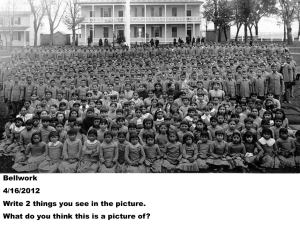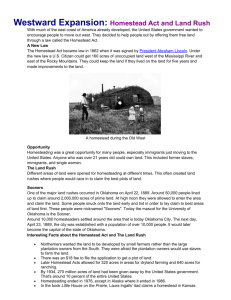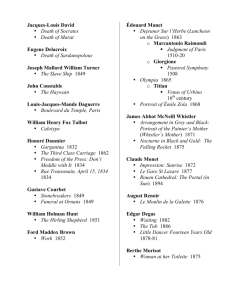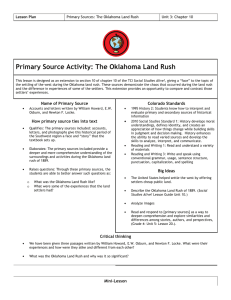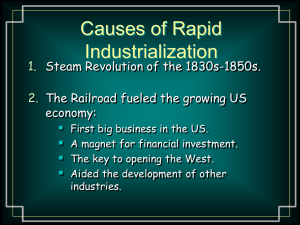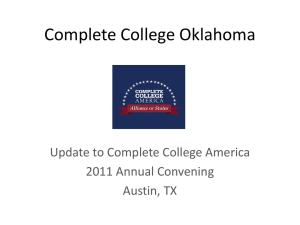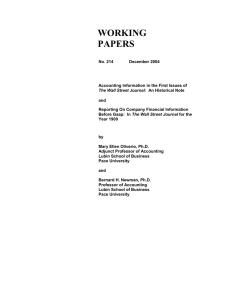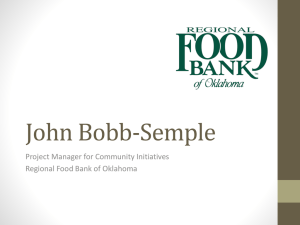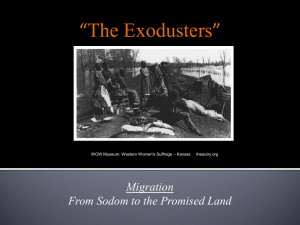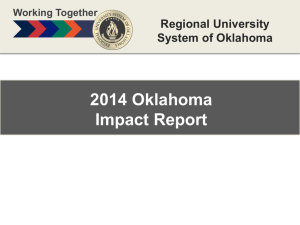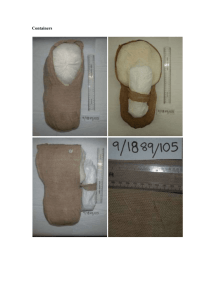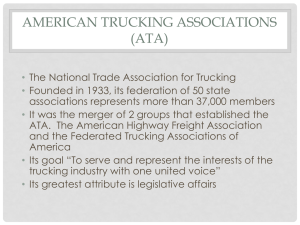Land Runs of Oklahoma - Jenks Public Schools
advertisement
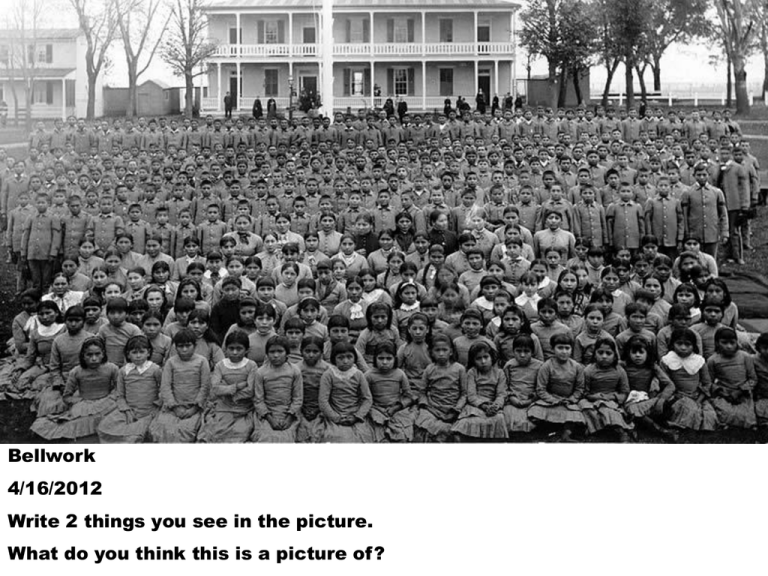
Bellwork 4/16/2012 Write 2 things you see in the picture. What do you think this is a picture of? Pupils at Carlisle Indian school, Pennsylvania. Established in 1879 by Richard Pratt, the school attempted to assimilate Indian children into the "white man's world" through education and financial support. Among its students were four of Comanche chief Quanah Parker's children and those of others involved in the Red River Wars Land Runs of Oklahoma CONFLICT Culture of Plains Indians Government Policy – Buffalo provided • Instead of food, clothing, continuing to move and shelter for the the Indians nomadic lifestyle of the Indians. westward, the They did not government believe land changed its policy. should be bought Indian land was and sold, and white farmers felt seized, and they it should be were forced onto divided. reservations. INDIAN WARS • Army troops attacked and massacred surrendering Cheyenne. Congressional investigators condemned the Army actions, but no one was punished in the Sand Creek Massacre. • After the massacre, Cheyenne and Sioux stepped up their raids. In return for closing a sacred trail, the Sioux agreed to live on a reservation. Other nations signed the Medicine Lodge Treaty and were moved to reservation lands in western Oklahoma. • George Armstrong Custer led his troops in headlong battle against Sitting Bull and lost. The Battle of the Little Bighorn was a temporary victory for the Sioux. The U.S. government was determined to put down the threat to settlers The Government Passes Legislation to grant land 1. Pacific Railway Acts of 1862 gave railroad companies 10 square miles of land on each side of the track for every mile of track laid they resold the land to settlers. $$$$ 2. Morrill Land Grant Act (1862) distributed millions of acres of land to state governments they could sell the land to found “land-grant” colleges. Homestead Act (1862) • offered 160 acres of land to settlers who farmed, built a house and stayed. Rules: were citizens or immigrants who had applied for citizenship paid a $10 registration fee built a house within six months farmed the land for 5 years before claiming ownership END OF RESERVATIONS • The Dawes Act of 1887 broke up many reservations and turned Native Americans into individual property owners. Ownership was designed to transform their relationship to the land. The Indians received less productive land, and few had the money to start farms. Most of the land given to the Indians was unsuitable for farming. Oklahoma Act of 1889 opened the last of the frontier to new settlers; the “Sooners” sneaked into the territory before the official start and claimed the best land. ORGANIC ACT • Set up government for Oklahoma • All Indian lands open for white settlement • All of Oklahoma available for settlement by 1901. www.nps.gov/home/images/wagon.gif April 22nd, 1889 • LAND RUN! • • • • Start on the line Race to the claim you wanted Pick up stake in ground Plant your stake and get title from claim office The starting line for the first Oklahoma Land Rush, April 22, 1889. http://www.archives.gov/education/lessons/homestead-act/images/homesteading-family.gif Base camp before the 1889 land run. Boomers at Arkansas City, Kansas, 1889. Photographer: William S. Prettyman. http://www.nationalcowboymuseum.org/research/images/r_a_cunn_imag_lr89_1913_lg.jpg Boomers on Kansas state line, April 19th, 1889. Photographer: William S. Prettyman. Waiting for land run at Purcell, Oklahoma Territory, 1889. Photographer: William S. Prettyman. Oklahoma City - April 29, 1889 Seven Days After the Land Run of 1889 ©2002 Oklahoma State Senate Historical Preservation Fund, Inc. and Wayne Cooper Type People Who Moved West 1. Speculators: people who bought large areas of land in hopes of reselling it for a profit 2. Homesteaders: people who rushed to accept offers of free land 3. Exodusters: • African- American settlers who moved west; took their name from the biblical account of the Jews escaping slavery in Egypt 4. Boomers: people who kept relocating from town to town looking for a quick fortune, but seldom staying long enough to make a living This poster urges Exodusters to move from Kentucky to Kansas. Kansas State Historical Society http://www.cjonline.com/stories/030203/our_ot.hist6.shtml Exodusters waiting for a steamboat to carry them westward in the late 1870's. Problems facing settlers 1. The extremely poor could not afford the “free” land 2. Land companies claimed most of the land, not individuals 3. Resettlement of the Native Americans C. Complaints of the Farmers 1. Low agricultural prices 2. Insufficient and expensive credit – 3. High rates charged by middlemen 4. High industrial prices 5. Demonetizing of silver (no more minted coins made from silver) The Populist Party Farmers’ Alliance: Organized to unify concerns of farmers with miners and factory workers. Effect: Farmers and labor unions formed a new political party Wanted: Free and unlimited coinage of silver RAILROADS & MINING A Rush for Gold. 1. People had been looking for gold since the ’49 rush in California 2. Discovery of silver in Nevada (the Comstock Lode) led to more strikes 3. By the late 1800s people flocked to the West, Canada, and Alaska http://i66.photobucket.com/albums/h270/kule1/479px-California_Gold_Rush_handbill.jpg “Boom to Bust” GOLD OR SILVER STRIKE Miners arrive to build a tent city Merchants arrive to supply miners Wood-frame structures replace tents BOOM TOWN Mining production falls Miners move on Stores close and merchants leave Town is abandoned GHOST TOWN E. Railroaders The federal government helped the railroad companies because it would benefit the entire nation; a subsidy is financial aid from the government. Transcontinental Railroad Central Pacific Promontory Point, UT 1869 Union Pacific the completion of the railroad 1.Sparked a spirit of unity in the country 2. New states admitted (NV, CO, ND, MT, WA) Problems with the railroad 1. labor was scarce dangerous, low pay, hard work 2. high rates because of no competition 3. discrimination regarding rates rebates to large shippers, rural service high 4. corruption bribery, free passes to government officials Rath & Wright's buffalo hide yard, showing 40,000 buffalo hides baled for shipment. Dodge City, Kansas, 1878. MAIN IDEA • Native Americans fought the movement of settlers westward, but the U.S. military and the persistence of American settlers proved too strong to resist.
